Team Building: Exploring Importance, Types, and Effectiveness in Teams
VerifiedAdded on 2023/04/11
|6
|932
|187
Essay
AI Summary
This essay provides an overview of team building, emphasizing its importance in enhancing organizational performance, problem-solving, and working relationships. It explores various types of teams, including cross-functional, problem-solving, employee involvement, self-managing, and virtual teams, highlighting their respective functions and benefits. The essay also addresses the advantages of teamwork, such as synergy and social facilitation, alongside potential drawbacks like social loafing. The author shares a personal experience of successfully organizing a community drug abuse awareness campaign through effective teamwork, underscoring the value of collaborative efforts in achieving significant outcomes. Desklib provides a platform for students to access similar essays and solved assignments.
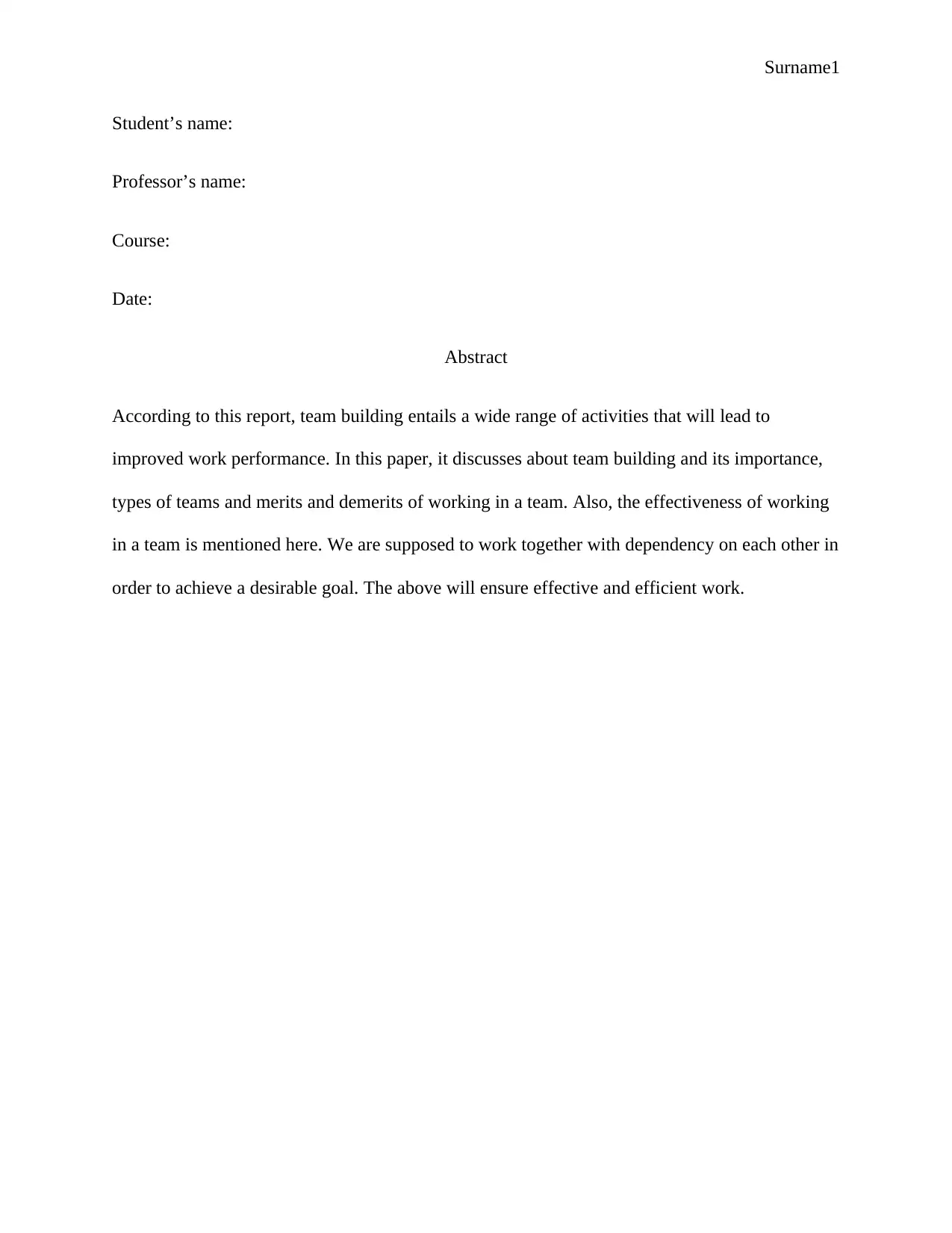
Surname1
Student’s name:
Professor’s name:
Course:
Date:
Abstract
According to this report, team building entails a wide range of activities that will lead to
improved work performance. In this paper, it discusses about team building and its importance,
types of teams and merits and demerits of working in a team. Also, the effectiveness of working
in a team is mentioned here. We are supposed to work together with dependency on each other in
order to achieve a desirable goal. The above will ensure effective and efficient work.
Student’s name:
Professor’s name:
Course:
Date:
Abstract
According to this report, team building entails a wide range of activities that will lead to
improved work performance. In this paper, it discusses about team building and its importance,
types of teams and merits and demerits of working in a team. Also, the effectiveness of working
in a team is mentioned here. We are supposed to work together with dependency on each other in
order to achieve a desirable goal. The above will ensure effective and efficient work.
Paraphrase This Document
Need a fresh take? Get an instant paraphrase of this document with our AI Paraphraser
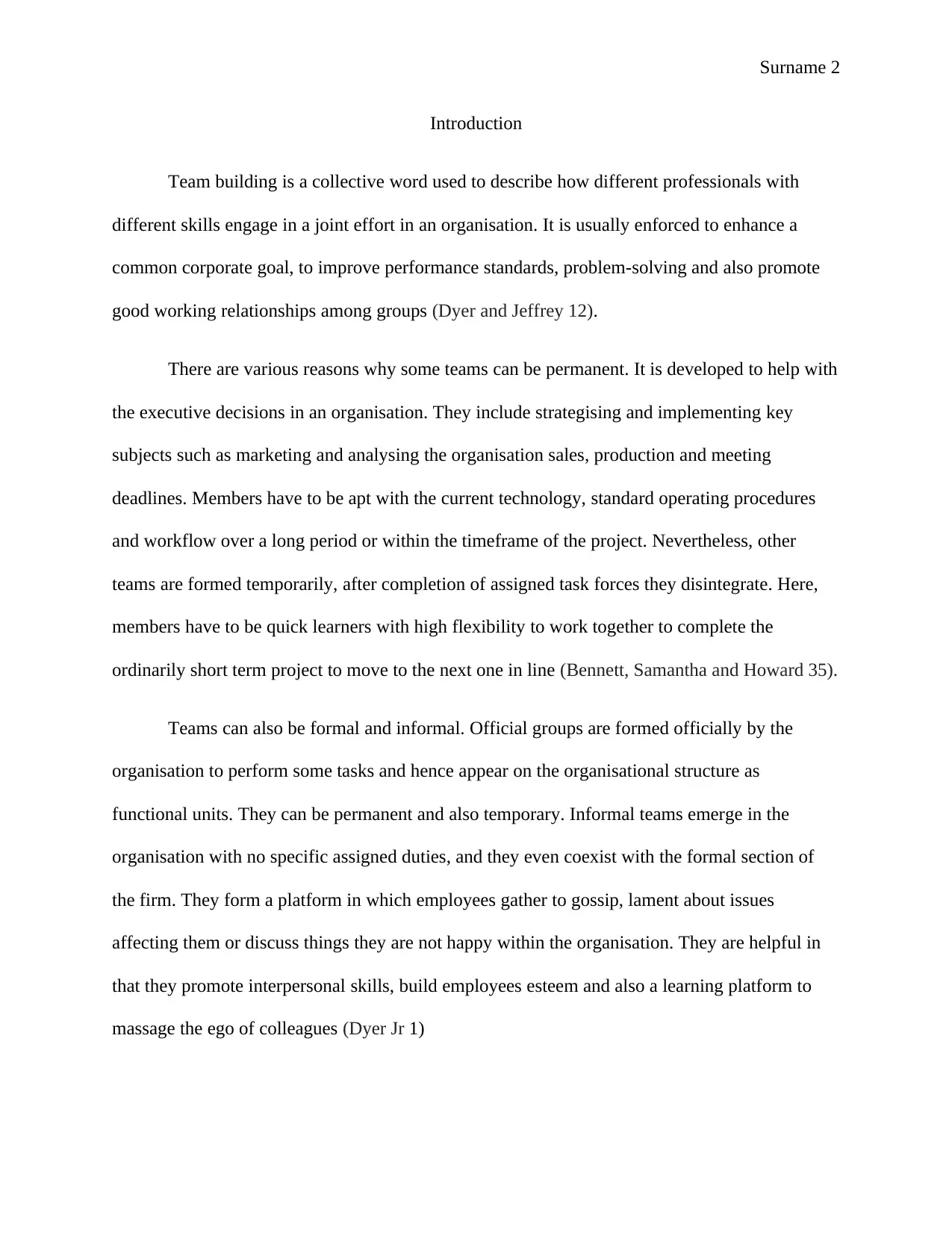
Surname 2
Introduction
Team building is a collective word used to describe how different professionals with
different skills engage in a joint effort in an organisation. It is usually enforced to enhance a
common corporate goal, to improve performance standards, problem-solving and also promote
good working relationships among groups (Dyer and Jeffrey 12).
There are various reasons why some teams can be permanent. It is developed to help with
the executive decisions in an organisation. They include strategising and implementing key
subjects such as marketing and analysing the organisation sales, production and meeting
deadlines. Members have to be apt with the current technology, standard operating procedures
and workflow over a long period or within the timeframe of the project. Nevertheless, other
teams are formed temporarily, after completion of assigned task forces they disintegrate. Here,
members have to be quick learners with high flexibility to work together to complete the
ordinarily short term project to move to the next one in line (Bennett, Samantha and Howard 35).
Teams can also be formal and informal. Official groups are formed officially by the
organisation to perform some tasks and hence appear on the organisational structure as
functional units. They can be permanent and also temporary. Informal teams emerge in the
organisation with no specific assigned duties, and they even coexist with the formal section of
the firm. They form a platform in which employees gather to gossip, lament about issues
affecting them or discuss things they are not happy within the organisation. They are helpful in
that they promote interpersonal skills, build employees esteem and also a learning platform to
massage the ego of colleagues (Dyer Jr 1)
Introduction
Team building is a collective word used to describe how different professionals with
different skills engage in a joint effort in an organisation. It is usually enforced to enhance a
common corporate goal, to improve performance standards, problem-solving and also promote
good working relationships among groups (Dyer and Jeffrey 12).
There are various reasons why some teams can be permanent. It is developed to help with
the executive decisions in an organisation. They include strategising and implementing key
subjects such as marketing and analysing the organisation sales, production and meeting
deadlines. Members have to be apt with the current technology, standard operating procedures
and workflow over a long period or within the timeframe of the project. Nevertheless, other
teams are formed temporarily, after completion of assigned task forces they disintegrate. Here,
members have to be quick learners with high flexibility to work together to complete the
ordinarily short term project to move to the next one in line (Bennett, Samantha and Howard 35).
Teams can also be formal and informal. Official groups are formed officially by the
organisation to perform some tasks and hence appear on the organisational structure as
functional units. They can be permanent and also temporary. Informal teams emerge in the
organisation with no specific assigned duties, and they even coexist with the formal section of
the firm. They form a platform in which employees gather to gossip, lament about issues
affecting them or discuss things they are not happy within the organisation. They are helpful in
that they promote interpersonal skills, build employees esteem and also a learning platform to
massage the ego of colleagues (Dyer Jr 1)
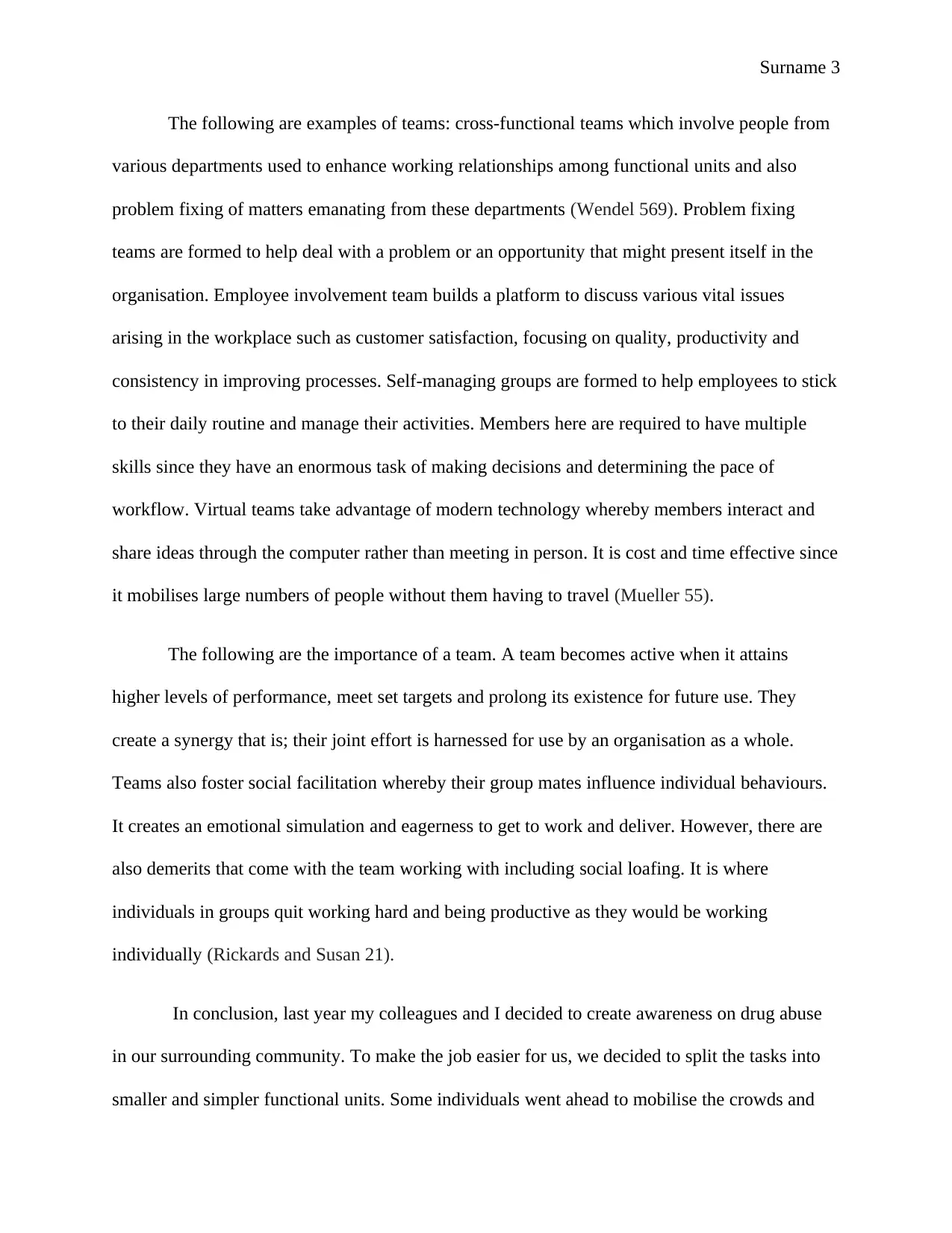
Surname 3
The following are examples of teams: cross-functional teams which involve people from
various departments used to enhance working relationships among functional units and also
problem fixing of matters emanating from these departments (Wendel 569). Problem fixing
teams are formed to help deal with a problem or an opportunity that might present itself in the
organisation. Employee involvement team builds a platform to discuss various vital issues
arising in the workplace such as customer satisfaction, focusing on quality, productivity and
consistency in improving processes. Self-managing groups are formed to help employees to stick
to their daily routine and manage their activities. Members here are required to have multiple
skills since they have an enormous task of making decisions and determining the pace of
workflow. Virtual teams take advantage of modern technology whereby members interact and
share ideas through the computer rather than meeting in person. It is cost and time effective since
it mobilises large numbers of people without them having to travel (Mueller 55).
The following are the importance of a team. A team becomes active when it attains
higher levels of performance, meet set targets and prolong its existence for future use. They
create a synergy that is; their joint effort is harnessed for use by an organisation as a whole.
Teams also foster social facilitation whereby their group mates influence individual behaviours.
It creates an emotional simulation and eagerness to get to work and deliver. However, there are
also demerits that come with the team working with including social loafing. It is where
individuals in groups quit working hard and being productive as they would be working
individually (Rickards and Susan 21).
In conclusion, last year my colleagues and I decided to create awareness on drug abuse
in our surrounding community. To make the job easier for us, we decided to split the tasks into
smaller and simpler functional units. Some individuals went ahead to mobilise the crowds and
The following are examples of teams: cross-functional teams which involve people from
various departments used to enhance working relationships among functional units and also
problem fixing of matters emanating from these departments (Wendel 569). Problem fixing
teams are formed to help deal with a problem or an opportunity that might present itself in the
organisation. Employee involvement team builds a platform to discuss various vital issues
arising in the workplace such as customer satisfaction, focusing on quality, productivity and
consistency in improving processes. Self-managing groups are formed to help employees to stick
to their daily routine and manage their activities. Members here are required to have multiple
skills since they have an enormous task of making decisions and determining the pace of
workflow. Virtual teams take advantage of modern technology whereby members interact and
share ideas through the computer rather than meeting in person. It is cost and time effective since
it mobilises large numbers of people without them having to travel (Mueller 55).
The following are the importance of a team. A team becomes active when it attains
higher levels of performance, meet set targets and prolong its existence for future use. They
create a synergy that is; their joint effort is harnessed for use by an organisation as a whole.
Teams also foster social facilitation whereby their group mates influence individual behaviours.
It creates an emotional simulation and eagerness to get to work and deliver. However, there are
also demerits that come with the team working with including social loafing. It is where
individuals in groups quit working hard and being productive as they would be working
individually (Rickards and Susan 21).
In conclusion, last year my colleagues and I decided to create awareness on drug abuse
in our surrounding community. To make the job easier for us, we decided to split the tasks into
smaller and simpler functional units. Some individuals went ahead to mobilise the crowds and
⊘ This is a preview!⊘
Do you want full access?
Subscribe today to unlock all pages.

Trusted by 1+ million students worldwide
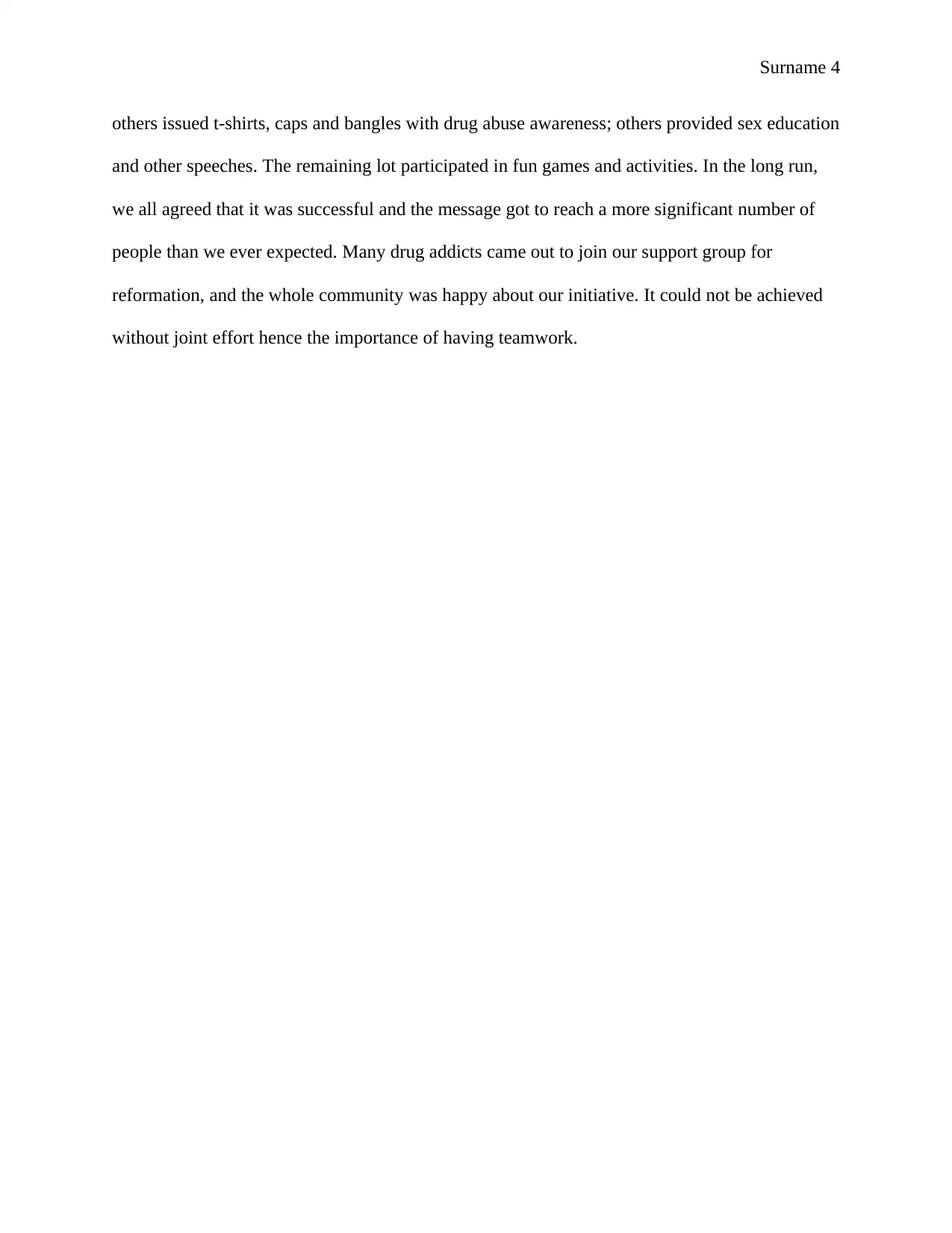
Surname 4
others issued t-shirts, caps and bangles with drug abuse awareness; others provided sex education
and other speeches. The remaining lot participated in fun games and activities. In the long run,
we all agreed that it was successful and the message got to reach a more significant number of
people than we ever expected. Many drug addicts came out to join our support group for
reformation, and the whole community was happy about our initiative. It could not be achieved
without joint effort hence the importance of having teamwork.
others issued t-shirts, caps and bangles with drug abuse awareness; others provided sex education
and other speeches. The remaining lot participated in fun games and activities. In the long run,
we all agreed that it was successful and the message got to reach a more significant number of
people than we ever expected. Many drug addicts came out to join our support group for
reformation, and the whole community was happy about our initiative. It could not be achieved
without joint effort hence the importance of having teamwork.
Paraphrase This Document
Need a fresh take? Get an instant paraphrase of this document with our AI Paraphraser
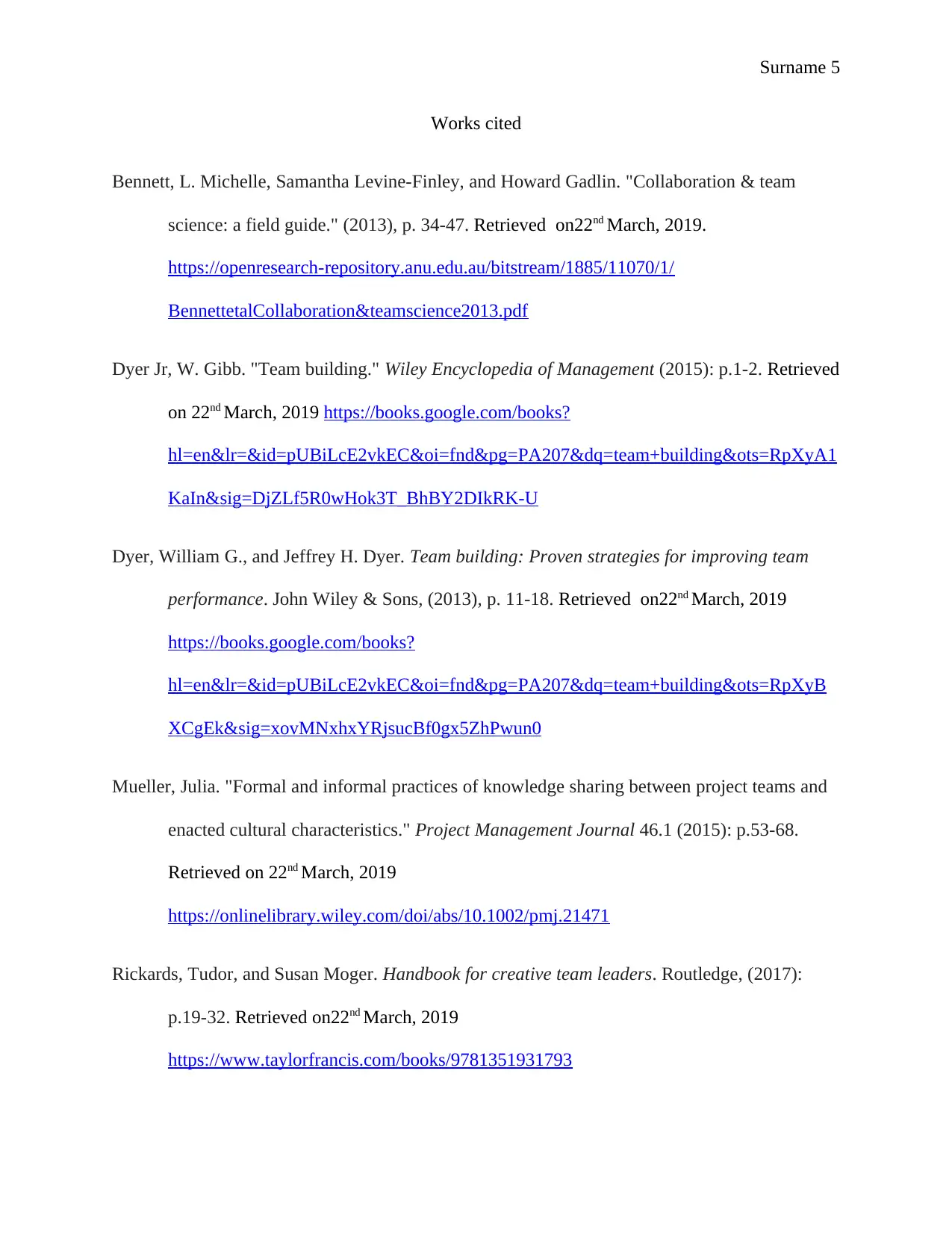
Surname 5
Works cited
Bennett, L. Michelle, Samantha Levine-Finley, and Howard Gadlin. "Collaboration & team
science: a field guide." (2013), p. 34-47. Retrieved on22nd March, 2019.
https://openresearch-repository.anu.edu.au/bitstream/1885/11070/1/
BennettetalCollaboration&teamscience2013.pdf
Dyer Jr, W. Gibb. "Team building." Wiley Encyclopedia of Management (2015): p.1-2. Retrieved
on 22nd March, 2019 https://books.google.com/books?
hl=en&lr=&id=pUBiLcE2vkEC&oi=fnd&pg=PA207&dq=team+building&ots=RpXyA1
KaIn&sig=DjZLf5R0wHok3T_BhBY2DIkRK-U
Dyer, William G., and Jeffrey H. Dyer. Team building: Proven strategies for improving team
performance. John Wiley & Sons, (2013), p. 11-18. Retrieved on22nd March, 2019
https://books.google.com/books?
hl=en&lr=&id=pUBiLcE2vkEC&oi=fnd&pg=PA207&dq=team+building&ots=RpXyB
XCgEk&sig=xovMNxhxYRjsucBf0gx5ZhPwun0
Mueller, Julia. "Formal and informal practices of knowledge sharing between project teams and
enacted cultural characteristics." Project Management Journal 46.1 (2015): p.53-68.
Retrieved on 22nd March, 2019
https://onlinelibrary.wiley.com/doi/abs/10.1002/pmj.21471
Rickards, Tudor, and Susan Moger. Handbook for creative team leaders. Routledge, (2017):
p.19-32. Retrieved on22nd March, 2019
https://www.taylorfrancis.com/books/9781351931793
Works cited
Bennett, L. Michelle, Samantha Levine-Finley, and Howard Gadlin. "Collaboration & team
science: a field guide." (2013), p. 34-47. Retrieved on22nd March, 2019.
https://openresearch-repository.anu.edu.au/bitstream/1885/11070/1/
BennettetalCollaboration&teamscience2013.pdf
Dyer Jr, W. Gibb. "Team building." Wiley Encyclopedia of Management (2015): p.1-2. Retrieved
on 22nd March, 2019 https://books.google.com/books?
hl=en&lr=&id=pUBiLcE2vkEC&oi=fnd&pg=PA207&dq=team+building&ots=RpXyA1
KaIn&sig=DjZLf5R0wHok3T_BhBY2DIkRK-U
Dyer, William G., and Jeffrey H. Dyer. Team building: Proven strategies for improving team
performance. John Wiley & Sons, (2013), p. 11-18. Retrieved on22nd March, 2019
https://books.google.com/books?
hl=en&lr=&id=pUBiLcE2vkEC&oi=fnd&pg=PA207&dq=team+building&ots=RpXyB
XCgEk&sig=xovMNxhxYRjsucBf0gx5ZhPwun0
Mueller, Julia. "Formal and informal practices of knowledge sharing between project teams and
enacted cultural characteristics." Project Management Journal 46.1 (2015): p.53-68.
Retrieved on 22nd March, 2019
https://onlinelibrary.wiley.com/doi/abs/10.1002/pmj.21471
Rickards, Tudor, and Susan Moger. Handbook for creative team leaders. Routledge, (2017):
p.19-32. Retrieved on22nd March, 2019
https://www.taylorfrancis.com/books/9781351931793
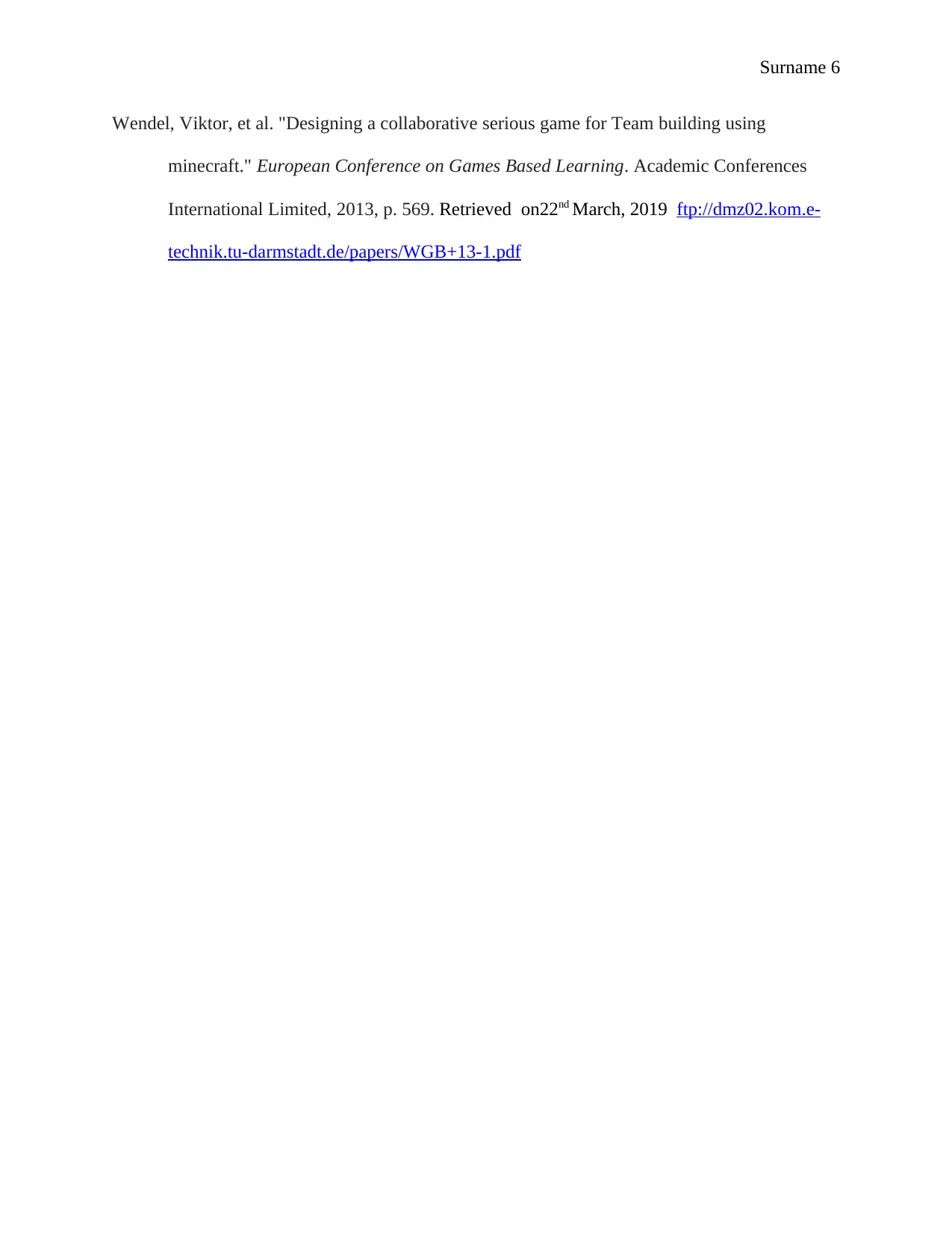
Surname 6
Wendel, Viktor, et al. "Designing a collaborative serious game for Team building using
minecraft." European Conference on Games Based Learning. Academic Conferences
International Limited, 2013, p. 569. Retrieved on22nd March, 2019 ftp://dmz02.kom.e-
technik.tu-darmstadt.de/papers/WGB+13-1.pdf
Wendel, Viktor, et al. "Designing a collaborative serious game for Team building using
minecraft." European Conference on Games Based Learning. Academic Conferences
International Limited, 2013, p. 569. Retrieved on22nd March, 2019 ftp://dmz02.kom.e-
technik.tu-darmstadt.de/papers/WGB+13-1.pdf
⊘ This is a preview!⊘
Do you want full access?
Subscribe today to unlock all pages.

Trusted by 1+ million students worldwide
1 out of 6
Related Documents
Your All-in-One AI-Powered Toolkit for Academic Success.
+13062052269
info@desklib.com
Available 24*7 on WhatsApp / Email
![[object Object]](/_next/static/media/star-bottom.7253800d.svg)
Unlock your academic potential
Copyright © 2020–2025 A2Z Services. All Rights Reserved. Developed and managed by ZUCOL.





